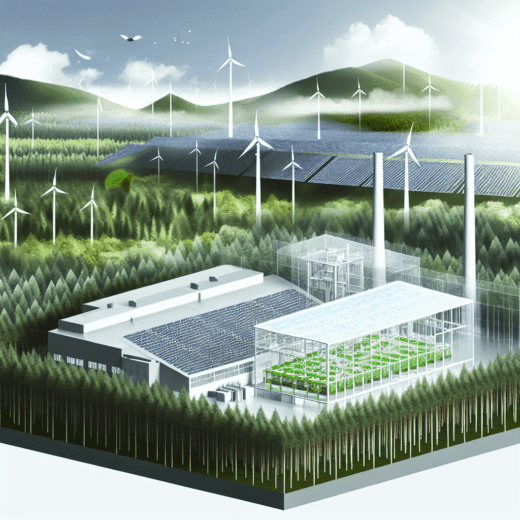Exploring the Promise of Forest Bioplastics: A New Frontier in Green Innovation
The burgeoning interest in sustainable materials has paved the way for groundbreaking innovations in eco-friendly manufacturing. Among these advances, forest bioplastics stand out as a promising alternative that harnesses renewable natural resources. Derived from forest resources such as wood pulp and plant residues, these bioplastics offer significant potential for market disruption across various industries. Given their environmental superiority over conventional plastics, forest bioplastics present remarkable opportunities and challenges, particularly within the startup ecosystem. This in-depth exploration highlights the innovation potential, market dynamics, and strategic pathways that could navigate startups through this promising landscape.
The Innovation Potential of Forest Bioplastics
As the global community increasingly pushes for sustainable business practices, forest bioplastics emerge as a potent solution. Traditional plastics, primarily made from petroleum, have long been criticized for contributing to pollution and climate change. Bioplastics, derived from biological substrates, provide a more sustainable alternative by reducing dependency on fossil fuels and minimizing carbon footprints.
Forest bioplastics, in particular, leverage resources like wood pulp and plant residues, making them attractive for both environmental and economic reasons. Innovation in this domain is driven by advancements in materials science and biotechnology, enabling the sustainable transformation of forest-based biomaterials into versatile bioplastics. These materials can be effectively used in a wide array of applications, from packaging to automotive parts, which positions them favorably against conventional plastics.
Market Disruption and Dynamics
As the movement towards sustainable materials gains traction, forest bioplastics are positioned to disrupt several key markets. Industries ranging from consumer goods and electronics to agriculture and pharmaceuticals are increasingly seeking eco-friendly options. This shift towards sustainable practices is not merely advocacy-driven but also rooted in consumer demand and regulatory pressures.
The market potential for forest bioplastics is amplified by the growing legislative push for reducing single-use plastics, pushing companies to explore biodegradable and compostable alternatives. Companies that invest in bioplastics are likely to benefit from brand loyalty and differentiation over competitors who rely on less sustainable materials.
Furthermore, collaborating with forestry and agricultural sectors enhances supply chain sustainability, potentially unlocking additional value for startups focusing on forest bioplastics. The seamless integration of forest-derived materials into existing manufacturing processes underscores the adaptability of bioplastics and their growing appeal to businesses globally.
Key Challenges in the Forest Bioplastics Landscape
Despite the promising potential, the path to thriving within the forest bioplastics space is not without obstacles. One significant challenge is the high production cost compared to conventional plastics. The cost factor is influenced by the complexity of converting raw plant materials into bioplastics and scaling these processes to meet commercial demands.
Technical challenges also persist, such as ensuring product consistency and optimizing the physical properties of bioplastics to match the performance of traditional plastics. The durability, strength, and flexibility required for various applications pose significant hurdles that require advanced research and technological interventions.
Additionally, awareness and perception issues need to be addressed. Educating businesses and consumers about the benefits and uses of bioplastics is crucial for market penetration. Overcoming the skepticism associated with “greenwashing” is another critical aspect where transparency and accountability in marketing and operations can play a transformative role.
Unique Opportunities for Startups
Startups have a distinctive advantage in the forest bioplastics arena, owing to their inherent agility and adaptability. Entering a niche market with growing environmental awareness provides an ample foothold for innovative solutions. The potential for creating bespoke, value-added products through the manipulation of forest resources is particularly exciting.
Strategic collaborations with academic institutions and research organizations enhance innovation capabilities, offering startups access to cutting-edge knowledge and technology that can drive product development. Furthermore, partnerships with larger corporations looking to integrate sustainable practices can serve as pivotal growth accelerators for startups in this sector.
Additionally, the capacity to customize products for specific markets adds a layer of competitive edge. The unique applications of forest bioplastics in diverse sectors open avenues for startups to take advantage of underserved markets or to create entirely new market segments.
Strategic Pathways for Success
Navigating the complexities of bringing forest bioplastics to market involves several strategic considerations. Firstly, achieving product-market fit is crucial. This requires a deep understanding of market needs and the development of bioplastic products that align perfectly with customer demands. Conducting thorough market research and pilots can provide invaluable insights into the viability and potential reception of new products.
Scaling the production of forest bioplastics is a substantial hurdle that demands innovation in manufacturing processes. Adopting advanced technologies such as bioengineering and leveraging automation could reduce costs and improve scalability, essential elements for competitive parity with traditional plastics.
An effective fundraising strategy is also pivotal for startups pursuing this path. Engaging with investors who are supportive of sustainable initiatives and demonstrating the value proposition of forest bioplastics as both a profitable and eco-friendly venture can unlock substantial financial resources.
Customer acquisition strategies should focus on transparency, sustainability, and tangible benefits. Positioning forest bioplastics as not just an environmental choice but a superior product in terms of performance and aesthetics can enhance market penetration. Establishing credible certifications and endorsements may further strengthen consumer trust and brand reputation.
Lastly, distinguishing the business model and technology is critical. Emphasizing proprietary innovations, sustainable sourcing practices, and unique production processes can build a compelling narrative that appeals to stakeholders across the spectrum, from consumers to investors.
Case Studies of Success
The forest bioplastics sphere has witnessed several pioneering startups that exemplify successful navigation of the market’s complexities. For instance, a startup like BioForeFront, which focuses on efficiently converting wood pulp into high-performance bioplastics, serves as a model of leveraging core technology to capture significant market share. Their partnerships with forestry companies not only ensure a sustainable supply of raw materials but also facilitate community engagement and regional economic development.
Similarly, companies like GreenFiber Tech have excelled by aligning their product offerings with consumer values of sustainability and functionality. By focusing on sectors such as packaging, where bioplastic advantages are quickly becoming non-negotiable, they have marked a pioneering path in integrating forest-derived materials with existing industrial systems.
Such success stories underscore the importance of strategic foresight and execution. As these companies show, maintaining a strong commitment to innovation and sustainability can create not just profitable business models but also contribute to broader ecological and social outcomes.
Conclusion: Towards a Sustainable Future
Forest bioplastics represent a revolutionary step toward sustainability in materials science. As the world grapples with the adverse impacts of conventional plastics, the shift towards materials derived from renewable forest resources holds immense promise. For startups, this domain offers an extraordinary confluence of environmental stewardship and economic opportunity. The path to success requires overcoming significant technical and market-related challenges, but the rewards of making meaningful contributions to sustainable development are substantial.
As the forest bioplastics industry continues to evolve, it invites entrepreneurs, investors, and innovators to partake in shaping a sustainable future. With concerted efforts in research, collaboration, and market understanding, stakeholders can propel forest bioplastics from the peripheries of innovation into mainstream applications. Aspiring startups in this field must seize this chance to make a lasting impact, combining visionary leadership with meticulous execution. Through such endeavors, forest bioplastics can not only transform industries but also help build a more sustainable world.
In conclusion, the journey of forest bioplastics and the startups championing this cause is one of resilience, creativity, and the pursuit of a cleaner planet. With strategic insight and a commitment to progress, the potential for transforming the bioplastics landscape is not just possible—it’s inevitable.

